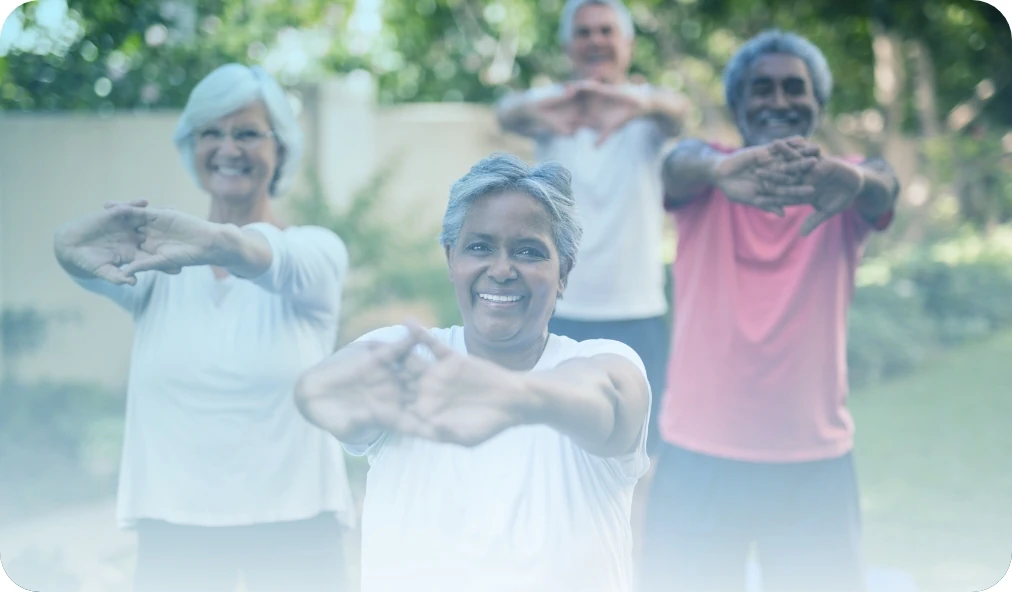Knees and hips. Isn’t it surprising how often these are the subject of conversation as we age? There’s good reason. Joint pain and stiffness are common afflictions for seniors, and our knees and hips are typically the most affected.
Loss of muscle mass, another common issue for seniors, contributes to joint problems by offering less support for these hardworking body parts.
While aging does bring challenges for joints (and muscles too), that doesn’t mean there aren’t things we can do. Find out how to keep your joints and muscles healthy, along with how to find a Medicare doctor near you to help.
Quick Facts about Your Joints
Joints are located where bones meet in the body, and daily wear and tear begin to take effect as we age. Most people eventually have some form of osteoarthritis, which occurs when the cartilage protecting the joints wears down naturally over time. Joints become less flexible.
Muscle loss is common with aging, and lack of muscle strength and extra body weight can add stress to your joints as well. Most muscle loss is due to lack of activity, so you can avoid that by staying active.
In fact, you can improve your joint health, muscle health, and flexibility, and even help alleviate joint pain by adopting some simple healthy habits.
Joint Health for Seniors
Let’s look at some of the best joint care tips for seniors.
Keep moving!
While joint pain and stiffness might seem like a reason to restrict movement, you should do the exact opposite. Everyone has heard “move it or lose it,” right? That rings true for joint health. Movement is good for joints and can even alleviate pain.
Maintain a healthy weight.
There are many benefits to maintaining a healthy weight, and better joint health is one of them. Too much weight puts additional pressure on our joints – particularly knees.
Supplements for joint health.
There is a variety of joint health supplements on the market and some of the common ones contain omega-3 fatty acids or glucosamine. It’s worth noting that you can add omega-3 fatty acids to your diet by consuming more fatty fish like salmon. If you don’t care for fish, fish oil capsules can offer the same benefits.
Before starting any supplement regimen, it’s important to first talk to your primary care doctor. (Need a primary care doctor? We can help you find doctors near you who provide value-based care.) They will have the best advice for you regarding the use of supplements and how they might interact with other medications you take.
Joint Exercises for Seniors
How can seniors maintain joint health? What are the best joint exercises for seniors?
If you’re ready to support your joints with exercise, it’s good to know you don’t need an expensive gym membership or fancy weightlifting equipment. Most joint exercises for seniors can be done at home, using either your own body weight or small, inexpensive weights.
Here are some things to keep in mind when choosing to exercise to support joint health.
Go low-impact.
What exercises are easiest on joints? Low-impact workouts are ideal for seniors and those with joint pain. Try swimming, strength training with small weights, yoga, Tai Chi, or other stretching exercises.
These exercises can help relieve joint pain by improving blood flow, loosening joints, and strengthening bones.
Add hip strengthening exercises.
The best hip strengthening exercises for seniors include standing hip flexors, standing hip extensions and bridges. There are also seated hip strengthening exercises.
Check the Internet for hip exercises for seniors, where you’ll find videos or images to explain these moves. Or talk to your primary care doctor.
Add knee strengthening exercises.
Leg extensions, seated knee extensions and hamstring curls are among the best knee strengthening exercises for seniors.
You can find more information online, or ask your primary care doctor about the best exercises for your mobility level.
Muscle Strengthening for Seniors
Don’t forget the importance of maintaining muscle strength to support joints. By helping maintain muscle mass, you will provide your joints with more support, promoting better joint health.
Strength train for muscle health.
Strength training does more than improve our muscle tone – it helps our joints. When we lose muscles that support our joints, it puts more pressure on them and adds to deterioration.
Start small.
Start with smaller weights and keep your first exercise sessions to approximately 10 minutes. Keep your movements slow.
It takes longer for your body to recover from workouts as you age. While some soreness is expected, give yourself a little time between workouts – at least 48 hours, in most cases.
Talk to Your Doctor
Always talk to your doctor before embarking on an exercise regimen. Your primary care physician can help guide you to the best options for health and wellness.
Do you need a primary care physician or a doctor who accepts Medicare? We can help you find one in your area who offers value-based care. Use our Find a Doctor service to locate a local primary care physician.


